The document discusses the history and development of probability theory. It begins by describing how the foundations of probability were established in the 17th century by Blaise Pascal and Pierre de Fermat through their study of games of chance. It then provides definitions and explanations of key probability concepts like sample space, events, and the probability of an event occurring. The document goes on to discuss different models for representing probability problems geometrically, including linear models, area models, and coordinate geometry models. It also covers famous probability puzzles and paradoxes like the Monty Hall problem, Bertrand's paradox, and the Sleeping Beauty problem. Finally, it briefly mentions some applications of probability in fields like quantum mechanics, polymer sciences, and























































